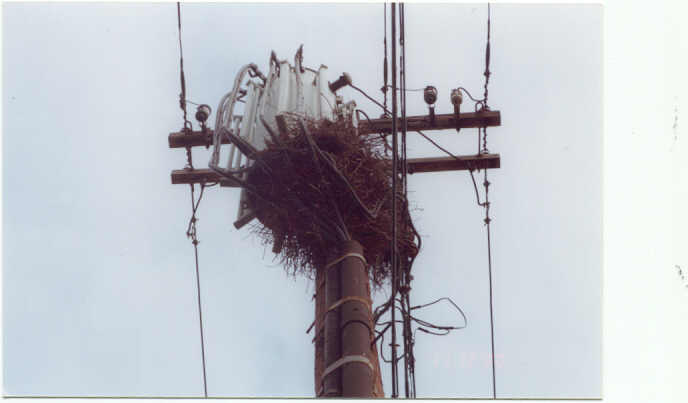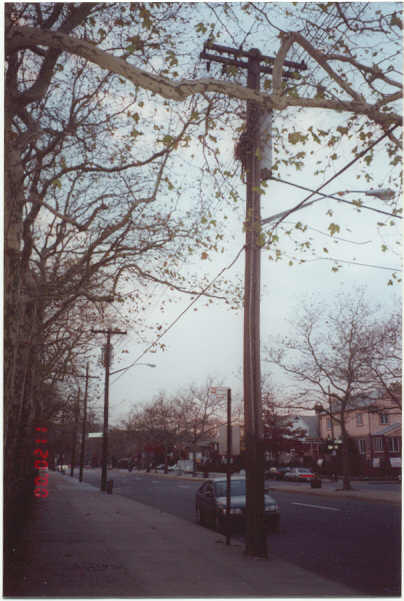

The Twig Twisting Tale of the Monk Parakeets
Authors:
Jamie Gevertzman
Tamara Sperling
Brian Russo
Abstract:
After observing many monk parakeet nests, we noticed they seemed to be made up of the same species of twigs. The question we are attempting to answer: Do Monk Parakeets use the same species of tree twigs to build their nests? Since they are the only species of parrots that build twig nests we thought it would be interesting to see if they had an affinity toward one species of trees. We decided that we would go visit many of the nests and collect, compare, and identify various tree twigs that had fallen from the nests to test our hypothesis. Our research has shown that the monk parakeets are not selective about the species of twigs that they collect to build their nests. Rather, they seem to use trees in the immediate area surrounding their nesting site.
Introduction:
The Monk parakeet is the only parrot of 300 members of the Psittacidae family to use twigs to build their nests. The nests can become large hulking structures that measure several feet in width and diameter. This large structure houses several pairs of Monk Parakeets. Some nests have been measured at over six feet long and three feet wide (Harrison 1973). One of the most unique characteristics of the Monk Parakeets is that they occupy the nest year round. Monk Parakeets can be seen carrying twigs three times the length of their own body to add to their nests. Upon arriving at their nests, they patiently poke, push and weave the stick into the structure. (Martella and Bucher 1993)
On the University of the Bridgeport campus, Monk Parakeets have built nests in the white pine trees on campus. The nests are large. One of the nests has been measured at 9 feet by 5 feet. Inside the signature stick nests of the Monk Parakeet is a nesting chamber that is 7 to 9 inches in diameter and connected by an entrance hole by a short tunnel. Monk Parakeet nests are started by a single pair of birds. The nests grow in size by having other pairs of monks add compartments to a single compartment nest. University Of Bridgeport Monk Parakeets
Their choice of nesting material is not as specific as their choice of nesting location. Research of fallen nests in Connecticut have shown that the birds use twigs from a variety of woody plants
(Olivieri and Pearson 1992). Thorny twigs or twigs with buds are usually preferred by Monk Parakeets. The reason for this is because they bind together better and provide extra protection against predators (Forshaw 1989). The strength of the twigs are also a factor in choosing this material since the base of the nest is built first.
Materials:
Procedure:
Results:
Site 1 - Manhattan Beach
Location - Shore Blvd. and Pembroke Street



Site 2 - Manhattan Beach
Location - Oriental Blvd. and Kensington Street



Site 3-Mill Basin
Location- Ave. T and E 53 Street



Site 4-Mill Basin
Location- Ave. T and E 59 Street


Site 5- Brooklyn College Football Field
Location-Campus Road and E 24 Street

Site 6- Midwood
Location- Ave. I and E 26 Street

Site 7-Midwood
Location-Ave. J and E Street

Site 8-Gerritsen Beach
Location- Seba Ave and Hyman Court

Discussion:
Monk Parakeets do not use only one species of twig to build their nests. In each of the sites, we found their to be five or more different species of twigs used. In each of the sites, the samples showed no numerical correlation from nest to nest. The locations that were studied were approximately 1-2 miles apart from each other. If the Monk Parakeets had preferred a single species of twig then the results would have shown the abundant presence of that single species.
Locating nesting sites outside of the Brooklyn College area seemed to be a laborious task. We spent many hours searching for the two nesting sites in Manhattan Beach. Fortunately, in discussing this project with friends and neighbors, they directed us to many of the nest locations. In the Mill Basin area, we found the first by hearing the signature Monk Parakeet Squawk.
The first problem we encountered was collecting enough samples to make an accurate conclusion as to the preference of species. We also realizes that it would be possible for samples to be dropped into the location directly underneath the nest by other means (i.e. wind, street sweepers, and/or humans). Twig identification also proved to be an arduous task. We would find samples and then compare them to trees in the immediate area surrounding the nests. One source of possible inaccuracy in our study maybe the miss identification of tree species although, we are positive that in classifying the samples that they are of different species. In attempting to recheck our twig identification data, we sought the help of a Park Ranger at Floyd Bennett Field. After many attempts to make contact there was no one available to help us.
As a follow-up study, it would be interesting to compare nesting materials from state to state. Our data supports the study of Olivieri and Pearson 1992, that Monk Parakeets are eclectic in their choice of nesting material. From the small amount of nets we have found, we believe that Monk Parakeets are a non threatening invasive species. Since they use twigs from different species of trees, we feel that they are not a threat to a single native tree species. Monk Parakeets are an invasive species that should be further studied to see how and if they are affecting other portions of the urban web of life.
Implications for Teaching:
This research project can be applied to our teaching practice in many ways.
The standards addressed here are:
S2 d] Demonstrates understanding of changes over time.
S5 a] Asks questions about organisms
S5 f] Works individually and in teams to collect and share information and ideas.
S7 a] Represents data and results in multiple ways.
S8 b] Demonstrates scientific competence by completing a systematic observation.
The standards addressed here are:
S2 c] Demonstrates understanding of organisms and their environments.
S4 b] Demonstrates understanding of the designed world.
S5 a] Ask questions about events and discoveries.
S5 c] Uses evidence from reliable sources to construct explanations.
S5 d] Evaluates different points of view using relative experiences, observations, and knowledge.
S6 a] Use technology and tools to gather data and extend senses.
S7 a] Represents data and results in multiple ways.
The standards addressed here are:
S6 a] Use technology and tools to gather data and extend senses.
S7 a] Represents data and results in multiple ways.
S7 c] Communicates in a form suited to the purpose and the audience.
S8 c] Demonstrates scientific competence by completing a design.
The standards addressed here are:
S2 a] Demonstrates understandings characteristics of organisms.
S2 c] Demonstrates understanding of organisms and environments.
S4 a] Demonstrates understandings of big ideas and unifying concepts.
S5 b] Uses concepts from Science Standard 1 to 4 to describe a variety of observed phenomena.
S5 d] Evaluates different points of view using relative experiences, observations, and knowledge.
S7 a] Represents data and results in multiple ways.
S7 c] Communicates in a form suited to the purpose and the audience
References:
Internet sites:
www.monkparakeet.com- An ongoing study of feral monk parakeets in North America. An online resource about monk parakeets and related topics.
www.quakerville.com- An educational site with information about the monk parakeet, their care and feeding.
www.bridgeport.edu/~robert/parrot.htm- An online article about the monk parakeets at the University of Bridgeport in Connecticut.
www.fw.vt.edu/dendro/forsite/idtwig.htm- An online identification guide for twigs from the University of Vermont School of Forestry.
www.gaia.flemingc.on.ca/~dhendry/trelec.htm - An online identification guide for trees.
http://academic.brooklyn.cuny.edu/education/miele/MonkParakeets.htm- A web site dedicated to the study of the feral monk parakeet population at Brooklyn College.